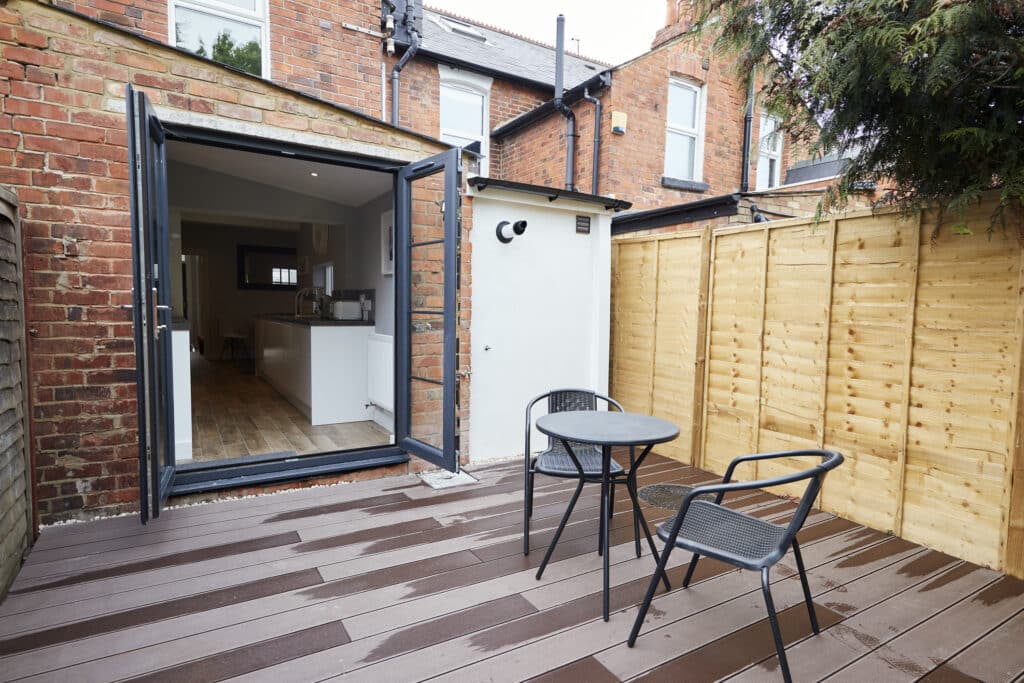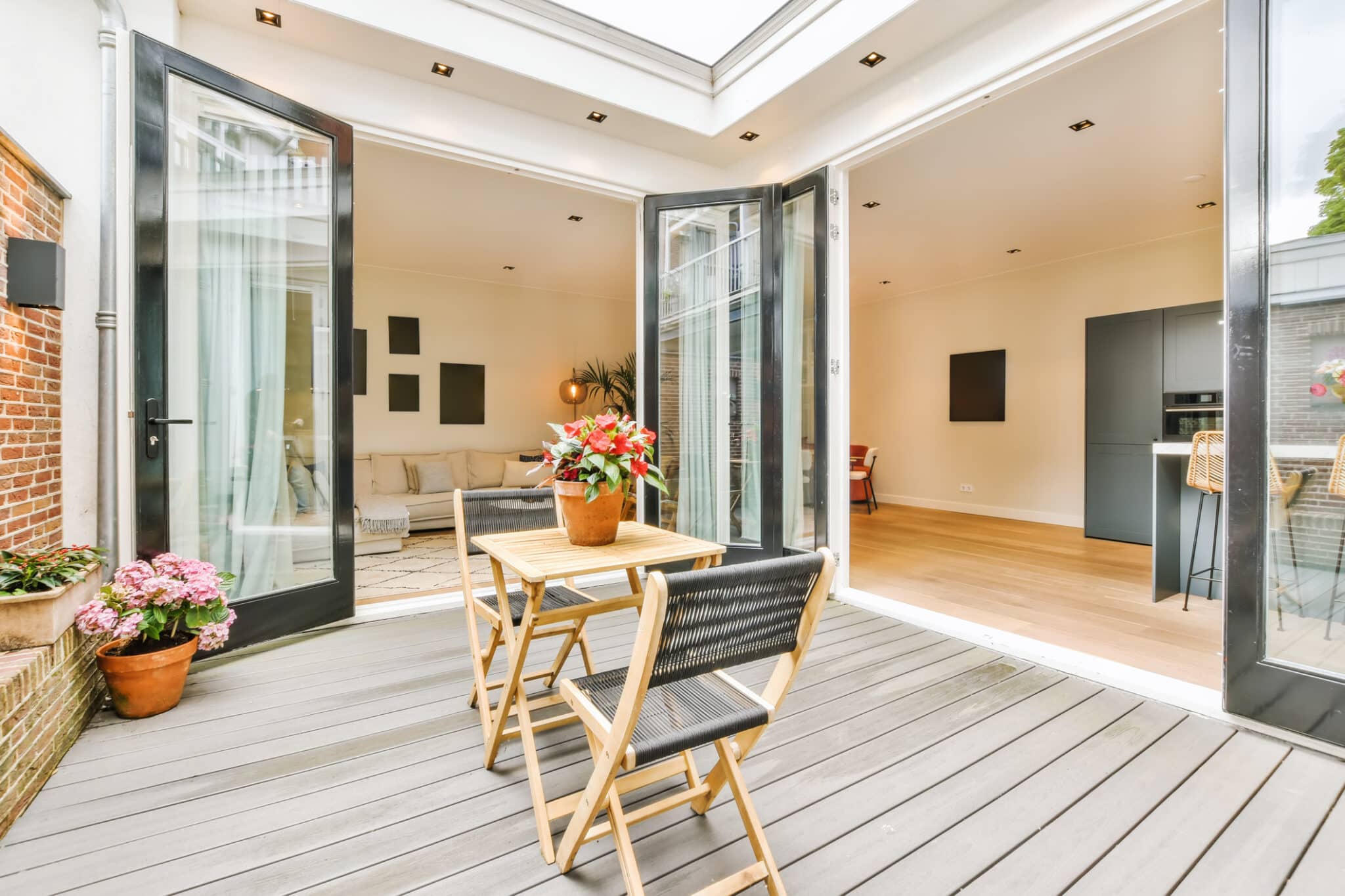
Why Your Patio Door Frame Material Matters
Wondering why patio door frame material is such a big deal? It might seem like a small detail, but the frame you choose can affect everything from your door’s appearance to its durability and energy efficiency.
Picture a door that not only looks great but also stands up to Texas weather, requires minimal upkeep, and helps keep your home comfortable year-round. In this guide, we’ll explore different patio door materials, breaking down the pros and cons so you can find the perfect fit for your home and lifestyle.
Understanding the Importance of Patio Door Frames
The patio door frame is more than just a support for the glass; it’s a crucial element that affects the door’s durability, insulation, and overall performance. A well-chosen frame can withstand the challenges of daily use, offer protection from the elements, and improve your home’s energy efficiency by helping maintain a stable indoor temperature.
For homes in Plano, TX, Lewisville, TX, and Flower Mound, TX, the right frame material can make a significant impact, from managing intense summer heat to resisting potential weather-related wear.

Common Patio Door Frame Materials and Their Pros and Cons
Choosing the right material for your patio door frame is like picking the perfect pair of shoes—you want something that looks good, feels right, and suits your lifestyle.
Patio door frames aren’t just about style; they impact how well your doors hold up over time, how energy-efficient your home is, and how much work you’ll need to put into maintaining them.
Let’s break down the most common materials, where they work best, and the pros and cons of each, in a way that’s easy to understand.
Wood
Wood frames are made from natural timber, and they’re the go-to option if you love that warm, classic vibe. You’ll often find wood frames in older or more traditional-style homes, but they’re also popular in upscale designs where elegance matters. The beauty of wood is that it’s highly customizable. Want a different look? Just paint or stain it to match your decor.
- Pros: Wood frames scream timeless charm. They give your patio doors a natural, cozy feel and can be tailored to match almost any color or design scheme. Plus, they’re great at keeping your home insulated, so your indoor temperatures stay comfortable year-round.
- Cons: The downside? Wood needs love. You’ll need to keep up with sealing, staining, or painting to protect it from moisture. If you live in a humid area, you might need to watch out for warping or swelling over time.
Vinyl
Vinyl frames are like the no-fuss, budget-friendly option that still gets the job done. They’re made from PVC, a type of plastic, and are popular in all kinds of homes because they’re affordable and easy to care for. Vinyl works well in areas with a variety of weather conditions, so whether it’s raining or shining, these frames hold up.
- Pros: Vinyl is super low-maintenance, which means no sanding, staining, or painting. It’s also energy-efficient because it keeps heat or cool air where it belongs—in your house. And let’s be real: the price tag is hard to beat.
- Cons: If you’re into funky or custom colors, vinyl might disappoint you. It comes in limited shades, and you can’t paint over it. Plus, in areas with extreme heat, vinyl can sometimes warp, so it’s not the best choice for super-hot climates.
Aluminum
Aluminum frames are like the sleek, modern cousin in the patio door world. Lightweight but super strong, they’re often found in homes with a contemporary vibe or for oversized doors where sturdiness is key. They’re common in urban homes or places where modern design rules.
- Pros: Aluminum frames are slim and strong, which means they can support large glass panels without adding too much bulk. They’re also pretty durable and don’t require a ton of maintenance.
- Cons: Aluminum isn’t a great insulator, so it’s not the best choice if energy efficiency is a top concern. It can also corrode if it’s exposed to moisture for long periods, so keeping it properly treated or coated is a must.
Fiberglass
Fiberglass frames are the heavy hitters when it comes to durability. They’re tough as nails, stand up to all kinds of weather, and provide excellent insulation. You’ll often find fiberglass in homes where people want a long-term solution without a lot of upkeep.
- Pros: Fiberglass lasts a long time and doesn’t warp, swell, or shrink like other materials. It’s also an energy-efficiency champ, helping keep heating and cooling costs down. Plus, it doesn’t need much maintenance, which is always a win.
- Cons: The biggest drawback? The price. Fiberglass is one of the more expensive options upfront, and it can be harder to find in certain colors or styles. But for many, the long-term benefits make it worth the investment.
Steel
Steel frames are all about strength and security. If you want something that feels rock-solid and provides peace of mind, steel is the way to go. You’ll often see steel frames in industrial-style homes or where security is a big priority.
- Pros: Steel frames are built to last. They’re incredibly strong, so they can handle heavy doors without any issues. They also give a clean, polished look that works well in modern designs.
- Cons: Steel is heavy, which means installation can be a bit trickier. And while it’s super durable, it can rust if it’s not treated properly. A little maintenance, like sealing or painting, is needed to keep it in top shape.
Factors to Consider When Choosing Patio Door Frame Material
Choosing the right patio door frame material involves considering several key factors that impact durability, energy efficiency, and maintenance. By evaluating how each material interacts with your environment and lifestyle, you can make a decision that will keep your patio door functioning well and looking great over the long term. Below are some of the most important considerations to keep in mind.
Climate and Weather Conditions
The local climate can have a significant impact on how well certain frame materials perform over time. For instance, high humidity can cause wood to warp or swell, while extreme heat may lead to vinyl frames warping or discoloring.
Materials like fiberglass and aluminum tend to handle a wide range of weather conditions well, offering resistance to warping, fading, and other climate-related issues.
Understanding how each material holds up to your area’s weather helps you choose a frame that requires less maintenance and provides long-lasting durability.
Maintenance Requirements
Each frame material comes with its own set of maintenance needs, which can affect the time and cost involved in keeping your patio door in good shape. Wood frames, while beautiful, often need regular sealing or painting to protect them from moisture and sun exposure.
Vinyl and fiberglass, on the other hand, are generally low-maintenance, needing only occasional cleaning to stay in top shape. If you prefer a patio door that doesn’t require much upkeep, materials like vinyl and fiberglass may be the best fit.
Energy Efficiency
The frame material you choose can also impact your home’s energy efficiency, helping maintain indoor temperatures and potentially lowering energy bills. Wood and fiberglass are known for their excellent insulation properties, making them ideal for energy-conscious homeowners.
Aluminum, while durable, is less insulating and may not be the best choice if energy efficiency is a top priority. Selecting a material that provides good insulation can help regulate your home’s temperature, reducing the need for excessive heating or cooling.
Cost and Budget
Budget is often one of the biggest deciding factors when choosing a patio door frame material, as each option varies in price. Vinyl frames are usually the most budget-friendly, offering good durability without a high price tag.
Wood and fiberglass tend to be more expensive but offer advantages in insulation and aesthetics that may be worth the investment. Consider both the upfront cost and the long-term value each material offers, as higher-quality options can reduce maintenance and replacement costs over time.
Installation Considerations Based on Material
When choosing a patio door frame material, it’s also essential to consider the installation process, as certain materials may require more expertise or specific tools to install correctly. Proper installation ensures your door functions smoothly, provides optimal insulation, and lasts longer without frequent repairs.
Complexity of Installation
Some frame materials are easier to install than others, with vinyl and aluminum generally offering straightforward installation processes due to their lighter weight and flexibility.
Wood frames, while beautiful, can be more complex to install, as they require precise measurements and careful handling to avoid issues like warping. Fiberglass and steel, while durable, may also be challenging to work with due to their rigidity or weight, which can make installation more labor-intensive.
Need for Professional Installation
While some handy homeowners may feel comfortable installing their own patio door frames, certain materials are best left to professionals.
Heavy or rigid materials like steel and fiberglass require specialized tools and experience to install correctly, which can ensure a snug fit and avoid issues down the line.
Improper installation can lead to drafts, water leakage, or operational issues, so for complex materials, hiring a professional can be a worthwhile investment.
Potential Installation Challenges
Each frame material brings its own potential challenges during installation, from handling and securing heavier options like steel to adjusting for expansion and contraction in wood.
Vinyl frames, while generally easier to install, can be prone to warping if not properly supported, especially in larger doors. Aluminum may need additional weatherproofing to prevent corrosion, especially in humid climates. Being aware of these challenges can help you and your installer prepare for a smooth and successful installation process.
Expert Tips for Choosing the Right Material
Selecting the right patio door frame material can feel overwhelming with so many options available, but a few expert tips can make the decision process smoother.
By evaluating your home’s needs, balancing style with practicality, and consulting professionals, you can confidently choose the best material for your patio door.
Assessing Your Home’s Needs
The first step in selecting a patio door frame material is assessing the specific needs of your home. Consider factors like the climate, your maintenance preferences, and how often you use the patio door.
Homes in hot or humid areas may benefit from materials that resist warping or moisture damage, while energy-conscious homeowners might prioritize materials with strong insulation properties. Tailoring your choice to your home’s unique conditions helps ensure your patio door stands the test of time.
Balancing Aesthetics and Functionality
While it’s important to choose a material that functions well, appearance matters too. For example, wood frames offer a classic, warm aesthetic that can enhance the charm of traditional or rustic homes, while sleek aluminum can complement a modern style.
Vinyl and fiberglass provide versatile options that look great while being highly functional. Balancing aesthetics with the practical benefits of each material allows you to select a frame that enhances both the look and utility of your home.
Consulting with Professionals
Even with thorough research, consulting with professionals can provide valuable insights that help in making a final decision. A local expert or installer can assess your home’s unique needs, recommend materials suited to your area’s weather, and discuss any installation requirements specific to each material.
They can also provide a realistic view of costs, installation challenges, and long-term benefits, making sure you feel confident in your choice.
Maintenance Requirements by Material
Once you’ve selected the right patio door frame material, understanding its maintenance needs can help you keep it looking and performing its best. Each material comes with its own level of upkeep, so choosing one that aligns with your lifestyle and maintenance preferences is key to hassle-free ownership.
Wood Maintenance Needs
Wood frames provide a classic look but require regular maintenance to preserve their beauty and prevent damage. They need routine sealing, staining, or painting to protect against moisture, sun exposure, and potential warping.
This maintenance can be more involved, but it keeps wood frames looking fresh and ensures their longevity. With proper care, wood frames can last for decades while maintaining their warmth and charm.
Low-Maintenance Options
For those seeking low-maintenance solutions, vinyl and fiberglass frames are popular choices. Vinyl requires only occasional cleaning with soap and water, making it one of the easiest materials to maintain.
Fiberglass, known for its resilience, holds up well against weather changes and generally needs minimal attention beyond cleaning. These materials are ideal for homeowners looking to minimize upkeep without sacrificing durability or aesthetic appeal.
Long-Term Care Tips
No matter which material you choose, a few simple care tips can help extend the life of your patio door frame. Regularly clean the frame to remove dirt and debris, which can prevent damage over time.
For metal frames like aluminum and steel, consider applying a protective coating to resist corrosion. Inspect the frame seasonally for any signs of wear or damage, addressing minor issues before they become larger problems. With these long-term care habits, you can enjoy a beautiful, functional patio door for years to come.
Upgrade Your Patio Door Frame with Expert Help from Energy Window Solutions!
Looking to find the perfect frame for your patio door? At Energy Window Solutions, we specialize in high-quality door solutions that match your style and stand up to the climate in Plano, Lewisville, and Flower Mound, TX.
Let our experienced team help you choose the best frame for lasting durability and energy efficiency. Contact us today to enhance your home’s comfort and curb appeal!

Frequently Asked Questions (FAQ)
Which door frame material offers the best insulation?
Wood and fiberglass frames are the top choices for insulation, keeping indoor temperatures stable and energy bills lower. They provide excellent thermal performance, especially in extreme weather conditions. For those focused on energy efficiency, these materials are ideal.
How do I maintain a wooden frame?
Wood frames need regular maintenance, including sealing, staining, or painting, to protect them from moisture and sunlight. Frequent care prevents issues like warping and cracking, extending the frame’s lifespan. With routine upkeep, wood frames retain their beauty and durability.
Are vinyl frames durable enough for extreme climates?
Vinyl frames are durable and withstand most climates, though extreme heat may cause slight warping. They offer a balance of resilience and low maintenance, making them popular for various weather conditions. Overall, vinyl is a dependable choice for long-lasting use, even in areas with frequent weather changes.
Can I paint or stain my doorframe?
Wood frames are ideal for painting or staining, allowing for customization to match your home’s style. While vinyl and fiberglass have more limited options, certain fiberglass frames can be painted if desired. This flexibility makes wood a favorite for those seeking a tailored look.
Which material is best for low maintenance?
Vinyl and fiberglass are the easiest to maintain, requiring only occasional cleaning to stay in good shape. These materials resist weather-related wear and need minimal upkeep over time. For homeowners seeking simplicity and durability without the hassle of regular maintenance, vinyl and fiberglass are top choices.


